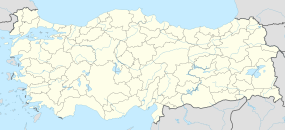Elaiussa Sebaste
| Ελαιούσα Σεβαστή | |

Theatre in Elaiussa Sebaste
|
|
| Alternate name | Elaeousa Sebaste |
|---|---|
| Location | Mersin Province, Turkey |
| Region | Cilicia |
| Coordinates | 36°29′01″N 34°10′25″E / 36.483624°N 34.173725°ECoordinates: 36°29′01″N 34°10′25″E / 36.483624°N 34.173725°E |
| Type | Settlement |
| History | |
| Founded | 2nd century BCE |
| Cultures | Cappadocian, Roman, Byzantine |
| Site notes | |
| Condition | In ruins |
Elaiussa Sebaste or Elaeousa Sebaste (Greek: Ελαιούσα Σεβαστή) was an ancient Roman town located 55 km (34 mi) from Mersin in the direction of Silifke in Cilicia on the southern coast of Anatolia (in modern-day Turkey). Elaiussa, meaning olive, was founded in the 2nd century B.C. on a tiny island attached to the mainland by a narrow isthmus in Mediterranean Sea.
Besides the cultivation of olives, the settlement here of the Cappadocian king Archelaus during the reign of the Roman Emperor Augustus played a role in the development of the city. Founding a new city on the isthmus, Archelaus called it Sebaste, which is the Greek equivalent word of the Latin "Augusta". The city entered a golden age when the Roman Emperor Vespasian purged Cilicia of pirates in 74 AD. Towards the end of the 3rd century AD however its importance began to wane, owing in large part to incursions by the Sassanian King Shapur I in 260 and later by the Isaurians. The ancient sources tell the history of city’s existence and how the churches and basilicas survived into the late Roman and early Byzantine periods. When its neighbor Corycus began to flourish in the 6th century AD, Elaiussa Sebaste was slowly obliterated from the stage of history.
The island that was the site of the first settlement here, where excavations have been underway since 1995 headed by Italian archeologist Eugenia Equini Schneider, is almost completely buried under sand. The original settlement, at a location that provided security for the harbors on either side, is a peninsula today. The ruins of a bath, a cistern, a defense wall and a breakwater can be seen on the side overlooking the western bay of the peninsula. But the most important remains unearthed in the city are a bath whose floor is paved with mosaics and a small basilica on a circular base.
...
Wikipedia

